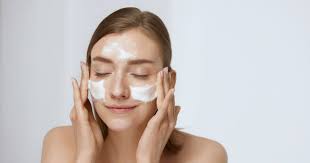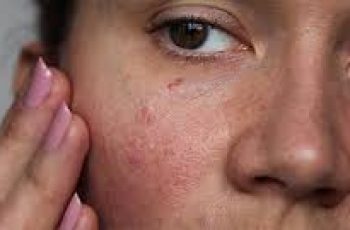
The Difference Between Foaming and Non-Foaming Cleansers: Which One Is Right for You?
When it comes to skincare, the right cleanser is the foundation of your routine.
But with so many cleansing options—foaming, non-foaming, cream cleanser, and oil-based—choosing the right one can feel overwhelming.
Understanding the differences between foaming and non-foaming cleansers will help you make an informed decision that suits your skin’s needs.
The best way to know what cleanser is right for you- is to take our skin type quiz. We will help you shop for cleansers that are right for you from many different brands,
Foaming cleansers are better for oily skin types
Non-foaming cleansers are better for dry skin types
Cream cleansers and cleansing oils are nonfoaming cleansers
Foaming cleansers leave skin tight and squeaky clean but can compromise the skin barrier
Foaming vs Non-Foaming Cleansers
Foaming cleansers are generally more effective at deep cleaning, making them ideal for removing makeup, sunscreen, and excess oil from the skin.
They contain surfactants that create bubbles and foam, which lift away dirt, oil, and impurities.
This makes foaming cleansers a popular choice for people with oily skin types, as they provide a thorough cleanse without leaving residue.
On the other hand, non-foaming cleansers may be oil-based, cream-based, or simply formulated with gentler surfactants that don’t produce foam.
These cleansers are better suited for dry or eczema-prone skin because they are less likely to strip the skin of its natural oils.
Non-foaming cleansers often deposit lipids back onto the skin, helping to maintain the moisture barrier.
However, they can be less effective at removing heavy makeup or sunscreen and might require additional steps like double cleansing to fully clean the skin.
Why Do Cleansers Foam?
Foam in cleansers forms when surfactants are present. Surfactants are special molecules with two ends: one that loves water and one that loves oils.
When you mix a cleanser with water and rub it between your hands, the surfactants push between water molecules, reducing the water’s surface tension.
This allows air to get trapped in the liquid, creating bubbles.
These bubbles are then surrounded by thin layers of the surfactant solution, creating foam.
The more surfactant molecules that arrange themselves at the water-air interface, the more stable and firm the foam becomes.
The surfactants essentially act as a “protective layer” around the bubbles, keeping them intact for longer and allowing the foam to form and stay stable.
However, no foam is permanent. Over time, gravity and internal pressure can cause the bubbles to pop, and the foam collapses.
Some surfactants, like ionic surfactants, are better at creating and stabilizing foam than others, such as non-ionic surfactants, which need a much higher concentration to create the same effect.
This is why some cleansers foam more than others, and why certain cleansers may feel richer with a thicker foam while others may feel lighter or barely lather at all.
Increasing Foam in Cleansers
To increase the foaming ability of a cleanser formulation, several strategies can be applied.
One effective method is choosing a surfactant with a higher charge, such as an anionic or cationic surfactant.
Anionic surfactants, like Sodium Lauryl Sulfate (SLS), are highly effective at creating foam due to their strong negative charge, while cationic surfactants can also boost foam stability.
Additionally, hard water can sometimes increase the foaming action, though it may also interfere with certain surfactants by forming soap scum.
pH plays an important role as well. A slightly acidic to neutral pH (around 5-6) can support foaming, as surfactants perform optimally within this range.
Too high or low pH can destabilize the foam, so maintaining the right balance is key.
To further enhance foam, adding emulsifiers or foam boosters like cocamidopropyl betaine can improve foam quality and stability.
These ingredients help prevent the collapse of bubbles, ensuring the foam lasts longer.
Additionally, using smaller, more stable bubbles through ingredients like long-chain fatty acids (e.g., lauric acid) can create richer, more stable foam.
Incorporating these methods helps formulators achieve a cleanser with richer, more satisfying foam.
The problem with vigorously foaming cleansers is that the surfactants used to create a rich foam can damage the skin barrier by pulling out important lipids.
These anionic surfactants, such as sulfates, are highly effective at removing dirt and oils, but they also strip away the natural fats that keep the skin’s protective barrier intact.
This can lead to dryness, irritation, and long-term damage to the skin’s natural defenses, making it more vulnerable to environmental irritants and moisture loss.
“A tight, squeaky clean feeling after a cleanser can be a sign to dry skin types that a cleanser is too harsh for their skin.”
Dermatologist Dr. Leslie Baumann MD
Foaming Cleansers: Deep Cleansing But Potentially Stripping
Foaming cleansers are great at removing oils, makeup, sunscreen, and impurities from the skin.
Because they contain surfactants that break down oils, they are best for people with oily skin.
Foaming cleansers clean thoroughly and leave the skin feeling tight and squeaky clean. However, there’s a downside to this thorough cleansing.
This tight squeaky clean feeling can be a warning to dry skin types that the cleanser is too strong for them.
Oily skin types prefer this squeaky clean feeling.
In about 20 minutes their skin will have made enough sebum to replace any missing lipids while dry types can remain uncomfortable for hours if they do not apply a moisturizer. (2)
Foaming Cleansers Can Compromise Your Skin Barrier
Many foaming cleansers, especially those containing anionic surfactants like sodium lauryl sulfate (SLS), can strip away the skin’s natural oils.
This is good if you make a lot of sebum, because there is a lot of oil for the cleansers to bind and remove.
If you do not have a lot of oil-soluble skin care products like sunscreen and face cream or sebum on the skin’s surface
Foaming cleansers can dry skin out and pull lipids from the skin barrier- messing up the water tight 3 dimensional structure.
Your skin barrier is a protective layer made up of lipids that prevent water evaporation off of the skin’s surface.
When these lipids are removed and the barrier is compromised, it can lead to dryness, irritation, and even eczema.
A compromised barrier can cause your skin to lose moisture more easily and become more susceptible to external irritants, allergens, pollution, toxins, and microbes.
How Often To Use A Foaming Cleanser
The frequency of using a foaming cleanser depends on your skin type.
If you have one of the 8 types of dry skin, it’s best to avoid foaming cleansers altogether, as they can strip your skin of essential moisture.
For those with normal, combination, or slightly oily skin, using a foaming cleanser once a day is usually sufficient to keep the skin balanced without over-stripping it.
For people with moderately to extremely oily skin, some might feel the need to cleanse twice a day.
But for most, using a foaming cleanser twice a day can be too much and may lead to over-cleansing, causing dryness, irritation, inflammation, and sensitivity.
Therefore, most oily skin types should stick to using a foaming cleanser once a day to avoid damaging the skin barrier.
The best time to use a foaming cleanser is during your nighttime routine, as this is when you need to thoroughly remove the sebum, makeup, and sunscreen that have built up throughout the day.
This allows your skin to be clean and refreshed without being stripped of its natural oils.
Foaming Cleansers Are Best for for Oily Skin Types
For clarity, when I refer to “foaming cleansers,” I mean those that contain strong surfactants that create long-lasting, stable bubbles.
These are the ones that provide a thorough cleanse and are typically better suited for oilier skin.
Foaming cleansers are most effective for oily skin types. They’re great at removing excess sebum and oil-based skincare ingredients, like chemical sunscreens.
However, people with dry or sensitive skin should be cautious. Foaming cleansers can over-cleanse dry skin, leaving skin feeling tight and stripped of its natural moisture.
Some cleansers labeled as “foaming cleansers” produce a weak foam with large, fragile bubbles that disappear quickly. These are often designed for dry skin types.
While they create a light foam, they aren’t truly foaming cleansers in the traditional sense.
You may see foaming cleansers advertised for dry skin because studies show that even people with dry skin tend to prefer the feel of foam—even though it may not be the best choice for them.
Non-Foaming Cleansers: Gentle but Less Cleaning Power
Non-foaming cleansers, such as cream or oil-based cleansers, don’t create the same bubbly lather but are still effective at cleansing.
Instead of relying on surfactants to break down oils, non-foaming cleansers often include emollients and oils that dissolve impurities.
Rather than stripping your skin of its natural oils, these cleansers help deposit lipids back into the skin, which helps maintain the moisture barrier.
For people with dry skin, non-foaming cleansers are a better option. These cleansers are barrier-safe and may focus on maintaining and reinforcing the skin’s lipid layer.
Many non-foaming cleansers use gentle ingredients like cocamidopropyl betaine or glycerin, which cleanse while adding moisture.
Many non-foaming cleansers leave a layer of lipids behind. This is why oily skin types say they do not feel clean when they use nonfoaming or oil-based cleansers.
This hydrated feeling of lipids on the skin is bothersome to oily ski types and soothing to dry ski types. This is one of the ways you can tell if your skin is dry or oily.
Types of Non-Foaming Cleansers
Non-foaming cleansers are designed to gently cleanse the skin without creating a lot of lather or foam.
There are three main types of non-foaming cleansers:
Cleansers with weak or uncharged surfactants
Cream cleansers
Oil cleansers
Cleansers with Weak Surfactants
Cleansers formulated with weak, uncharged surfactants, like nonionic and amphoteric surfactants, are much gentler on the skin compared to traditional surfactants.
They have thin, weak, unstable foam.
Nonionic surfactants, such as decyl glucoside or cocamidopropyl betaine, don’t carry a charge, making them effective at cleaning without stripping the skin’s natural oils.
These surfactants still bind to dirt and oil but don’t produce much foam, which is why they are often found in non-foaming cleansers designed for sensitive or dry skin.
Micellar cleansers are a great example of products that use weak surfactants, even though many people think of them as just water.
These cleansers contain micelles, which are tiny clusters of surfactant molecules that surround and lift dirt, oil, and makeup off the skin.
Micellar waters are non-foaming, but how gentle they are depends on the type of surfactant used.
Cleansing Oils
Cleansing oils dissolve the oils, sunscreen, makeup, and dirt on your skin, gently lifting them away without disrupting the skin’s natural moisture barrier.
They leave a layer of fatty acids on the skin’s surface.
When choosing a cleansing oil, it’s important to select one that contains non-comedogenic oils, which means they won’t clog your pores.
Oils like jojoba oil, argan, or grapeseed oil are excellent choices because they effectively dissolve makeup, sunscreen, and impurities while being lightweight and non-greasy.
Cleansing oils are ideal for dry skin types. They don’t rely on surfactants to cleanse but rather emulsify when water is added, allowing for easy rinsing.
How Oil Cleanses the Skin
Oil cleansers work on the principle that “like dissolves like”—meaning that oil is effective at dissolving excess sebum, makeup, and sunscreen.
When you massage an oil-based cleanser into your skin, it binds to the oils and dirt, lifting them off the skin’s surface.
When you rinse, the oils, along with the impurities, are washed away, leaving your skin clean but hydrated.
Oils can be found in cleansing oils, cleansing lotions, and cream cleansers, and cold creams.
Creamy Cleansers
Cream cleansers are typically oil-in-water emulsions that use small amounts of oil emulsified in water.
These cleansers may also contain humectant ingredients like glycerin or glycosaminoglycans that make the cleansers feel slippery and skin feels dewy after cleansing.
Cream cleansers utilize mild surfactants like cocamidopropyl betaine or decyl glucoside, which create less foam, ensuring the skin is gently cleansed without being stripped of its natural oils.
How Cleanser Choice Affects Your Skin Care Routine
Your choice of cleanser influences how the rest of your products perform.
We take these issues into account when we design a custom skin care routine for you.
Foaming Cleansers Effects On Absorption of Other Products
Foaming cleansers, which strip away oils, leave the skin clean, unprotected by occlusive lipids, and ready to absorb serums and moisturizers .
Because these cleansers remove lipids from the barrier and the skin’s surface, your skin can more easily absorb the active ingredients in your next steps, like retinoids or vitamin C serums.
Non-Foaming Cleansers Affects on Products in the Routine
On the flip side, non-foaming cleansers leave behind a layer of moisture and lipids, which can slow the absorption of other products.
This can be a benefit for dry skin. This may make certain serums less effective, as the lipid layer could act as a barrier to their absorption.
Cleanser pH Effects on the Skin Care Routine
The pH can dramatically affect how well other ingredients adsorb or function. For example- we know that aqueous Vitamin C absorbs best at a pH of 2-2.5.
The pH of a cleanser also plays a significant role in how it affects your skin. The skin’s natural pH is slightly acidic, around 5.5 , which helps maintain a healthy skin barrier.
Foaming cleansers have a varied pH that depends on which surfactants they contain. However, some foaming cleansers such as soap can have a pH as high as 9!
Non-foaming cleansers —especially cream-based cleansers—tend to have a higher pH, which can slow product absorption but is gentler on the skin. These types of cleansers are often around pH 5.5 to 7.
Summary
The cleanser you choose for your skincare routine significantly impacts the effectiveness of your entire regimen.
If you have dry skin, it’s important to use a non-foaming cleanser to avoid stripping your skin of essential moisture.
The only time a dry skin type should use a foaming cleanser is for removing heavy makeup, such as Halloween or stage makeup .
After cleansing, it’s crucial to thoroughly rinse the cleanser away and immediately follow up with a barrier-repairing moisturizer to restore hydration and support the skin’s natural protective barrier.
For oily skin , a foaming cleanser can help control excess oil, but strong, vigorously foaming cleansers should only be used once a day, preferably during your nighttime routine.
This ensures the removal of makeup, sunscreen, and excess sebum built up throughout the day without over-stripping the skin. This is why you may need 2 different cleansers in your skin care routine.
If you need help designing your skin care routine, take our skin care routine quiz.


